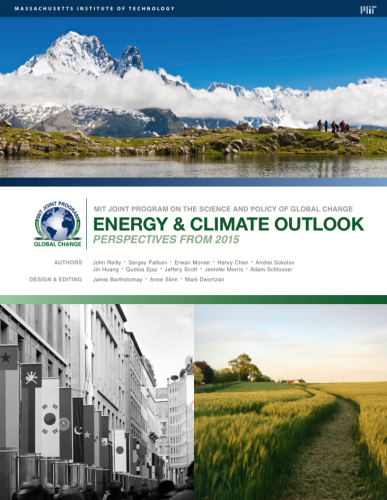2015 Energy and Climate Outlook

The 2015 Energy and Climate Outlook provides an integrated assessment of how human activities, given our current development path, are interacting with complex Earth systems and ultimately affecting the natural resources on which we depend. It uses the Integrated Global System Modeling (IGSM) framework, a projection modeling system developed by the Joint Program, to determine the associated energy, climate, atmosphere, ocean, and land-use implications.
The Outlook is a projection, not a prediction—the future will ultimately be determined by actions taken to stabilize our relationship with the planet in the coming decades.
We incorporate the emissions targets proposed by the international community to address the challenges of climate change. The United Nations Framework Convention on Climate Change (UNFCCC) reached an accord in 2009 for the so-called Copenhagen pledges, which were further specified in the Cancun agreements in 2010. These pledges are set to expire in 2020, but several large emitting countries have submitted proposals for post-2020 mitigation targets ahead of the COP21 negotiations.
Our objective is to show how far the current pledges take us, and what is at risk if we fail to push beyond these emissions reduction goals.
Key findings in the 2015 Outlook
A principal product of this Outlook is the supplemental data: a detailed set of economic, energy, land use, water stress, and emissions projections for each of the 16 major countries or regions of the world, through the year 2050. We provide this numerical data in the hopes that researchers and policymakers will find them useful for their own analyses.
Download: Outlook 2015 projection tables
Changes in Energy and Emissions:
With emissions stable and falling in developed countries, on the assumption that Copenhagen-Cancun pledges are met and retained in the post‑2030 period, future emissions growth will come from the Other G20 and developing countries.
- Growth in global emissions results in 64 Gt CO2-equivalent emissions in 2050, rising to 78 Gt by 2100—a 63% increase from 2010. By 2050, developed countries account for about 15% of global emissions, down from 30% in 2010.
- CO2 emissions from fossil fuels remain the largest source of GHGs. Other greenhouse gas emissions and non‑fossil energy sources of CO2 account for almost 33% of total global GHG emissions by 2100 (down slightly from previous estimates).
- Emissions from electricity and transportation will together account for about 51% of global CO2 emissions from fossil fuel use (decreasing slightly from 56% in 2010).
- Through 2050, fossil fuels account for about 75% of primary energy, despite rapid growth in renewables and nuclear (in part because the natural gas share of primary energy also increases).
Changes in Climate:
We predict accelerated changes in global and regional temperatures, precipitation, land use, sea level rise and ocean acidification.
- Global mean surface temperature increase ranges from 1.9–2.6°C by 2050 (relative to the 1860–1880 mean), and 3.1–5.2°C (central estimate 3.7°C) by 2100.
- Global mean precipitation increase ranges from 3.9–5.3% by 2050 (relative to the 1860–1880 mean), and 7.1–11.4% (central estimate 7.9°C) by 2100.
- Thermal expansion and land glacier melting contribute 0.15–0.23 meters to sea level rise by 2050, and 0.30 to 0.48 meters by 2100.
- More carbon in the ocean leads to increasing acidity, and the average ocean pH drops from 8.13 in 2010 to about 7.82 by 2100.
Impacts of Emissions Reduction Proposals for COP21:
- Based on intended COP21 contributions, we estimate 64 Gt CO2‑eq emissions in 2050—about 13 Gt less than our 2014 Outlook estimate, which only considered Copenhagen–Cancun pledges.
- Under the proposed cuts, the emissions path still far exceeds levels consistent with the 2°C goal often used as a target in climate negotiations.
- Assuming the proposed cuts are extended through 2100 but not deepened further, they result in about 0.2°C less warming by the end of the century compared with our 2014 estimates.
- On this emissions path, by 2030 the world will be within about 5 years of hitting the cumulative emissions level that the Intergovernmental Panel on Climate Change (IPCC) Working Group I shows to be consistent with a 50% chance of keeping the temperature increase below 2°C.
- With high climate sensitivity, the 2°C target may be exceeded in as little as 15 to 20 years from now. Even with low climate sensitivity, the 2°C target will be passed shortly after mid-century.
